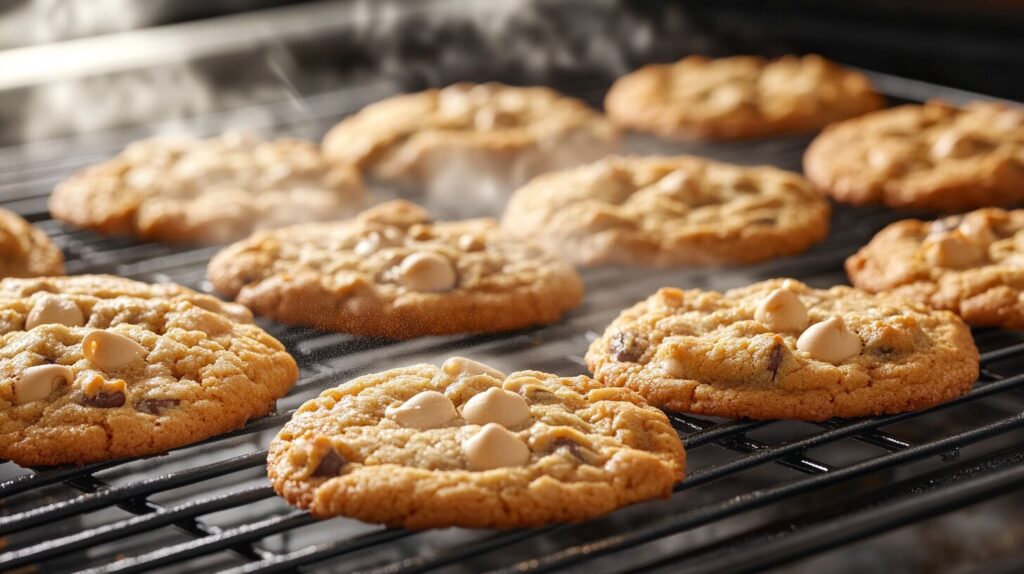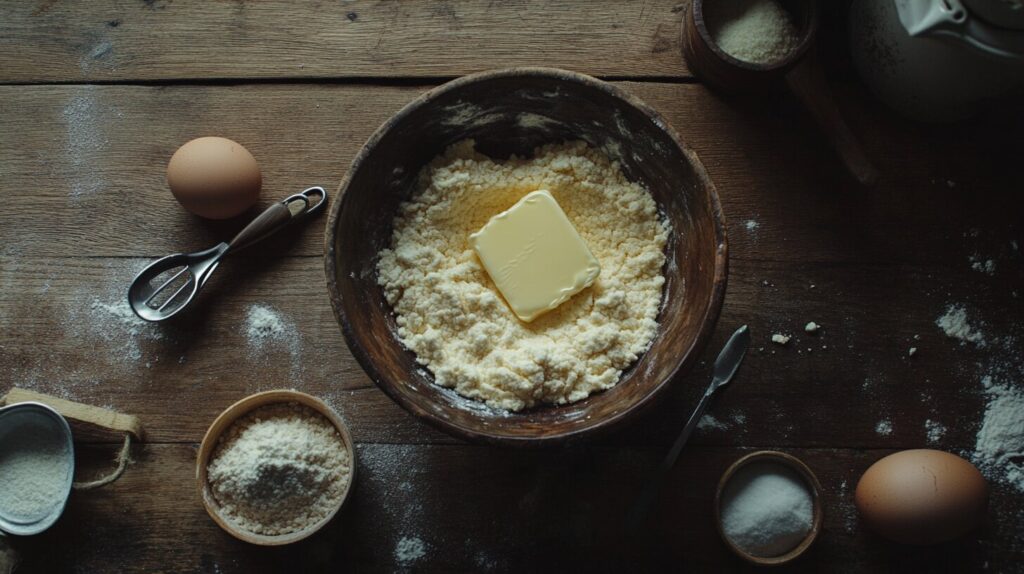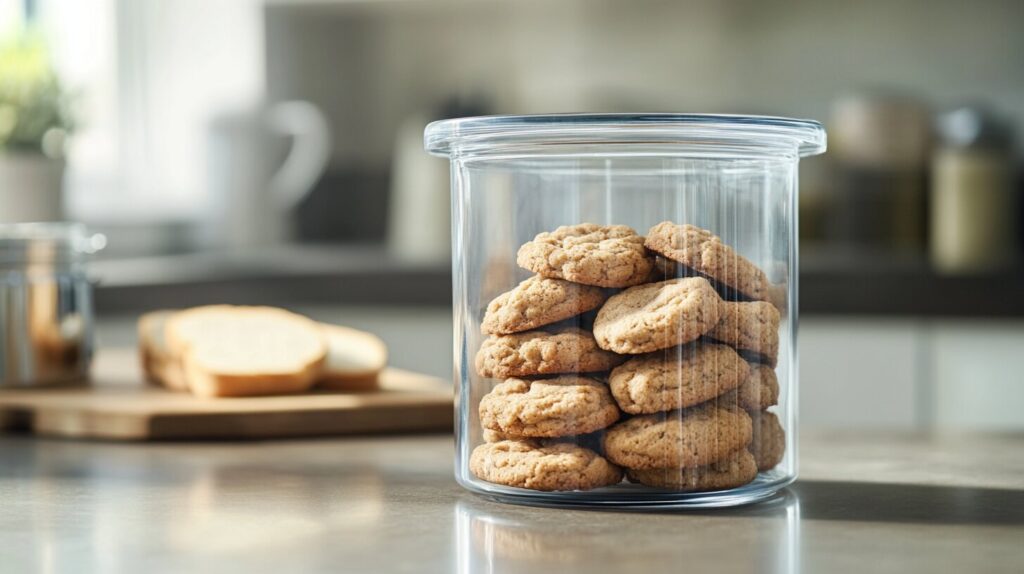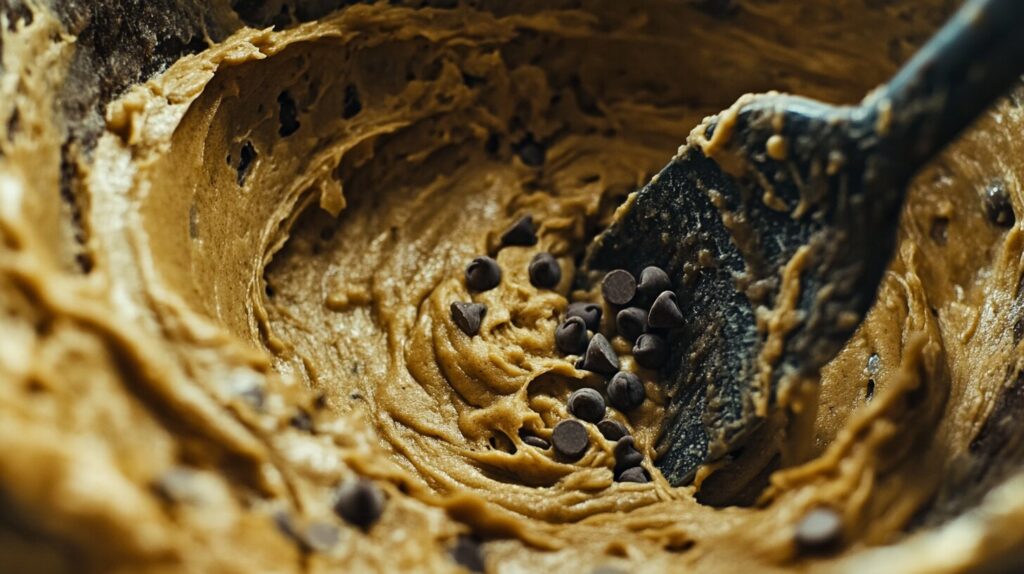
Let’s face it—nothing beats the joy of biting into a warm, chewy, melt-in-your-mouth cookie. However, we’ve all faced the frustration of cookies that turn rock-hard just hours after baking. As a result, you may wonder, what really keeps cookies soft and delightful? Interestingly, while there’s no single answer, there are a few secret ingredients and, more importantly, techniques that can transform your cookies from meh to magical. 🍪 With that in mind, let’s explore how to achieve cookie perfection!
In this guide, we’ll dive into the science, the essential ingredients, and the tried-and-true techniques behind creating—and maintaining—those irresistibly soft cookies we all crave. By the end, you’ll have all the tools you need to ensure every batch is a chewy, tender delight.
Ready to discover the secrets? Let’s get started! 🚀
Table of Contents
Understanding Cookie Texture: Why Softness Matters
Ever wondered why some cookies stay soft and others harden up faster than you’d like? Texture is everything when it comes to cookies. Think of it like a pillow: the fluffier it is, the more inviting it becomes. A cookie with the right softness is like a warm hug for your taste buds.
Soft cookies have a unique charm. They stay tender, chewy, and have that perfect snap when you bite into them. Softness often means the cookie has retained moisture, whereas hard cookies have lost it. The secret to keeping cookies soft is really about how you manage and preserve that moisture.
Why Do People Prefer Soft Cookies?
You know that feeling when you pull a tray of freshly baked cookies out of the oven and can’t resist grabbing one? It’s warm, gooey, and each bite is like a burst of happiness. That’s the magic of a soft cookie. It’s nostalgic, comforting, and satisfying.
But why do we love soft cookies so much? It’s a mix of psychology and sensory pleasure. Soft cookies often remind us of childhood treats or homemade goodies. They’re also easier to chew and digest, making them universally appealing.
✅ Fun Fact:
People often associate soft cookies with freshness, while hard cookies can feel stale, even if they aren’t.
The Science Behind Soft Cookies
Alright, science lovers—this part’s for you! 🧪 Keeping cookies soft isn’t just luck; it’s a delicate balance of moisture, fat, and technique. Understanding the science behind soft cookies can help you bake the perfect batch every time.
How Moisture Affects Cookie Softness
Moisture is the backbone of a soft cookie. When you’re mixing dough, you’re essentially combining wet and dry ingredients. The key is to ensure there’s enough moisture and to keep it locked in.

- Wet Ingredients: Things like eggs, butter, honey, and milk contribute moisture. The more moisture in the dough, the softer your cookies will be.
- Hygroscopic Ingredients: Some ingredients are “hygroscopic,” meaning they attract and hold onto moisture. Brown sugar and honey are prime examples. They don’t just add sweetness—they trap water, keeping cookies tender for longer.
Think of moisture like fuel for your cookies. Without it, they’ll dry up faster than a puddle in the desert. To keep cookies soft, you need to use ingredients that love moisture and baking techniques that preserve it.
🗨️ Pro Tip:
Want to keep your cookies moist longer? Try storing them with a slice of bread! The bread shares its moisture, keeping your cookies fresh and soft. 🍞

The Role of Fat in Soft Cookies
If moisture is the fuel, fat is the engine of a soft cookie. Butter, shortening, and oil all play different roles in achieving that perfect texture.
- Butter: Adds flavor and a slight crispiness to the edges while keeping the center tender. However, too much butter can lead to spreading.
- Shortening: Helps cookies hold their shape and stay soft because it has no water content. It’s excellent for cookies that need to stay chewy for days.
- Oil: Keeps cookies very moist but can sometimes make them greasy if overused.
Fats coat the flour particles, preventing too much gluten from forming. Gluten is great for bread (hello, chewy crusts! 🥖) but not for cookies. Less gluten = softer cookies.
🗨️ Did You Know?
Using melted butter instead of softened butter can make cookies chewier since it affects how the fat integrates with the flour.
Common Ingredients That Influence Cookie Texture
Every cookie recipe starts with the basics: flour, sugar, fat, and eggs. But it’s how you use these ingredients that makes all the difference. Let’s break down the key players in the soft-cookie game.
Flour: The Foundation of Texture
Flour is the skeleton of your cookie. It gives structure, but too much flour can make cookies dry and cakey. The type of flour matters, too.
- All-Purpose Flour: The go-to for most cookie recipes. It strikes a balance between softness and structure.
- Cake Flour: Contains less protein, making it ideal for extra-soft cookies. It creates a finer, more delicate texture.
The Gluten Factor
Gluten is the stretchy protein that forms when flour meets water. In cookies, you want just enough gluten to hold things together, but not so much that they turn into bread.
👉 Quick Tip:
Mix your dough just until the flour disappears. Overmixing = more gluten = tougher cookies.

The Importance of Sugar Types in Soft Cookies
Ah, sugar—the sweet star of the show! But did you know the type of sugar you use affects cookie texture?
- Brown Sugar: The MVP of soft cookies. Thanks to its molasses content, it traps moisture and gives cookies that chewy goodness.
- White Sugar: Great for crispy edges but not so great for softness. Too much white sugar = dry, crunchy cookies.
- Honey or Corn Syrup: These liquid sweeteners are hygroscopic, meaning they pull moisture from the air and keep your cookies soft for longer.
🧁 Analogy Alert:
Think of white sugar as the crunch-maker and brown sugar as the cuddle-bringer. The more brown sugar, the more your cookies hug you back!
Eggs and Their Role in Maintaining Softness
Eggs are like the glue holding everything together. They also add moisture and fat, depending on how you use them.
- Egg Whites: Mostly water and protein. They add structure but can make cookies drier if overused.
- Egg Yolks: Packed with fat, they make cookies richer and softer.
🥚 Pro Tip:
For softer cookies, try adding an extra egg yolk or swapping out one whole egg for two yolks.
What Is the Secret Ingredient to Keep Cookies Soft?
You’ve been patient, and now it’s time for the real magic: the secret ingredients that can make or break your cookie softness. While many factors affect texture, certain ingredients act like little baking wizards, keeping moisture locked in and making your cookies next-level chewy and tender.
Let’s reveal these secret ingredients and how they work their magic! 🧙♂️✨
The Power of Cornstarch in Cookie Dough
Cornstarch might seem like an unassuming pantry item, but it’s one of the best-kept secrets for soft cookies. So, why is it so effective? Because it works like a texture enhancer. Specifically, cornstarch interferes with gluten formation, which helps cookies stay tender and delicate.
- How to Use It:
Try adding 1-2 teaspoons of cornstarch to your cookie dough. This small amount can make a huge difference in texture. - Why It Works:
Cornstarch absorbs moisture without adding any flavor. Consequently, it reduces the density of the dough, giving you a light, soft, almost cake-like texture. Think of it as giving your cookies a little cushion to rest on. 😌
🗨️ Baking Tip:
For ultra-soft chocolate chip cookies, add a tablespoon of cornstarch to your dry ingredients. You’ll be amazed by the results!
Honey: A Natural Softening Agent
Honey isn’t just for tea or toast—it’s a cookie’s best friend, too! This golden nectar is hygroscopic, meaning it draws moisture from the air and keeps your cookies soft and chewy for days.
- How to Use It:
Replace 1/4 cup of sugar with honey in your favorite cookie recipe. As a result, you’ll get a softer texture and a subtle, sweet flavor boost. - Why It Works:
Honey’s natural sugars attract and retain water, which means your cookies stay moist longer. Plus, it adds a lovely depth of flavor that plain sugar can’t match.
🍯 Analogy Alert:
Adding honey to your cookies is like giving them a tiny moisture magnet. They’ll stay soft and irresistible, like a fresh-baked hug.
Why Cream Cheese Can Keep Cookies Soft
Cream cheese isn’t just for bagels and cheesecakes—it’s a game-changer for cookies. Adding a little cream cheese to your dough can work wonders for softness.
- How to Use It:
Replace half the butter in your recipe with cream cheese. For example, if your recipe calls for 1 cup of butter, use 1/2 cup butter and 1/2 cup cream cheese. - Why It Works:
Cream cheese contains both fat and moisture, which helps create rich, tender cookies. Furthermore, it adds a subtle tangy flavor that balances the sweetness perfectly.
🧀 Did You Know?
Cream cheese’s moisture content keeps cookies from drying out too quickly. It’s like adding a cloud of softness to your dough.
Top Techniques to Retain Cookie Softness After Baking
Okay, so you’ve nailed the ingredients—but what about the techniques? Even the best cookie dough can turn into a batch of bricks if you don’t handle it right. Therefore, let’s explore some tried-and-true methods to keep your cookies soft long after they’ve left the oven.
Proper Mixing Methods for Soft Cookies
Mixing cookie dough seems simple enough, but there’s a science to it. Overmixing can turn your cookies into tough little hockey pucks. Here’s how to do it right:
- Cream Butter and Sugar Properly:
Creaming butter and sugar together creates tiny air pockets, giving your cookies a lighter texture. Therefore, beat them until the mixture is fluffy and pale—usually 2-3 minutes. - Don’t Overmix the Flour:
Once you add the flour, mix just until you can’t see any streaks. After all, overmixing develops gluten, which makes cookies tougher. - Chill Your Dough:
Chilling the dough for at least 30 minutes helps the flavors meld and prevents cookies from spreading too much. As a result, this leads to thicker, softer cookies.
🗨️ Baking Wisdom:
“Mix with love, not with muscle. Your cookies will thank you.” 💪❤️
How to Prevent Overbaking and Dry Cookies
Overbaking is the archenemy of soft cookies. One extra minute in the oven can turn chewy goodness into crispy disappointment. Therefore, here’s how to avoid it:
- Watch the Edges:
Take cookies out of the oven when the edges are just set, but the centers still look slightly underbaked. They’ll firm up as they cool. - Use an Oven Thermometer:
Ovens can be sneaky liars. Consequently, an oven thermometer ensures you’re baking at the correct temperature (usually 350°F for cookies). - Cool on the Pan:
Let cookies cool on the baking sheet for 5-10 minutes before moving them to a wire rack. This helps them finish baking gently.
🍪 Pro Tip:
When in doubt, underbake! It’s easier to salvage an underbaked cookie than an overbaked one.
Storing Cookies to Keep Them Soft Longer
You’ve baked the perfect batch of soft cookies. Now, how do you keep them that way? Proper storage can make all the difference between a cookie that stays soft and one that turns into a hockey puck overnight. 🏒
Using Airtight Containers Effectively
Airtight containers are your best friend when it comes to keeping cookies fresh. Here’s how to use them like a pro:
- Layer with Parchment Paper:
Stack cookies with parchment paper in between to prevent them from sticking together. - Keep Them Separate:
Store different types of cookies separately. After all, soft cookies and crisp cookies don’t mix well—moisture from the soft cookies can make the crisp ones soggy. - Room Temperature is Best:
Keep your cookies at room temperature in an airtight container. Avoid the fridge unless the recipe calls for it.
🗨️ Quick Tip:
“Seal the softness in! Airtight means no air, no problem.” 👍
The Trick of Adding Bread to Your Cookie Jar
This old-school trick works like magic! Place a slice of white bread in the container with your cookies. As a result, the bread shares its moisture, keeping the cookies soft.
- Why It Works:
The cookies absorb moisture from the bread, staying tender for days. - Change the Bread:
Remember to replace the bread slice every couple of days to keep things fresh.
🍞 Analogy Alert:
The bread acts like a moisture lifeboat, keeping your cookies afloat in a sea of softness.
Common Problems and Solutions for Keeping Cookies Soft
Even when you follow the perfect recipe and use the best techniques, things can sometimes go wrong. We’ve all been there—cookies that come out hard, dry, or stale way too quickly. But don’t worry! For every problem, there’s a solution. Let’s go through some common cookie issues and, more importantly, how to fix them.
Why Do Cookies Turn Hard Quickly?
It’s the dreaded cookie hardening problem. You pull out a warm, soft batch, but the next day, they’re tough and crumbly. So, what went wrong?
- Overbaking:
One of the most common culprits is overbaking. Even an extra minute in the oven can rob your cookies of moisture. - Insufficient Moisture:
Additionally, if the dough didn’t have enough moisture to begin with, your cookies are bound to dry out faster. - Improper Storage:
Lastly, leaving cookies exposed to air will dry them out in no time.
Solution:
To avoid these issues, here are a few key tips you can follow:
- Bake Just Until the Edges Set:
Remember, cookies continue to bake on the sheet even after you take them out of the oven. Therefore, pull them out when the centers are still slightly soft. - Add Moisture-Rich Ingredients:
Next time, try using more brown sugar, honey, or an extra egg yolk to retain moisture. - Store Properly:
Always store cookies in an airtight container with a slice of bread to keep them soft longer.
🗨️ Quick Fix:
“When life gives you hard cookies, soften them up with a little bread magic.” 🍞✨
How to Soften Already Hardened Cookies
If your cookies have already gone hard, don’t panic! Fortunately, there are a few easy ways to bring them back to life.
- The Bread Trick:
First, place a slice of bread in the container with the hardened cookies. In just a few hours, the cookies will absorb moisture from the bread and become soft again. - Microwave Magic:
Alternatively, wrap the cookies in a damp paper towel and microwave them for 10-15 seconds. This quick burst of steam can rehydrate your cookies. - Oven Revive:
If the microwave isn’t an option, heat the cookies in the oven at 300°F for 3-5 minutes. This gentle warming can help soften them slightly.
🍪 Pro Tip:
If you know your cookies tend to harden quickly, freeze some of the dough and bake fresh batches as needed. After all, nothing beats a warm cookie straight from the oven!
Recipes That Showcase Soft Cookie Perfection
Now that we’ve covered all the secrets, tips, and tricks, it’s time to put them to good use. Here are two delicious recipes that highlight everything you’ve learned about keeping cookies soft. These cookies will be the soft, chewy treats of your dreams! 🌟
Classic Chocolate Chip Cookies with Cornstarch
Ingredients:
- 1 cup unsalted butter, softened
- 1 cup brown sugar, packed
- 1/2 cup granulated sugar
- 2 large eggs
- 2 teaspoons vanilla extract
- 2 cups all-purpose flour
- 2 teaspoons cornstarch
- 1 teaspoon baking soda
- 1/2 teaspoon salt
- 1 cup semi-sweet chocolate chips
Instructions:
- Cream Butter and Sugar:
First, in a large bowl, cream together the butter, brown sugar, and granulated sugar until light and fluffy (about 2-3 minutes). - Add Wet Ingredients:
Next, beat in the eggs one at a time, followed by the vanilla extract. - Mix Dry Ingredients:
Meanwhile, in a separate bowl, whisk together the flour, cornstarch, baking soda, and salt. - Combine:
After that, gradually add the dry ingredients to the wet ingredients, mixing until just combined. Then, fold in the chocolate chips. - Chill the Dough:
For best results, chill the dough in the refrigerator for at least 30 minutes. This helps with thickness and softness. - Bake:
When you’re ready, preheat the oven to 350°F (175°C). Scoop tablespoon-sized balls of dough onto a parchment-lined baking sheet. Bake for 9-11 minutes, until the edges are set but the centers are still soft. - Cool and Enjoy:
Finally, let the cookies cool on the sheet for 5 minutes before transferring them to a wire rack. Enjoy them warm and gooey!
🗨️ Baking Wisdom:
“Cornstarch is the unsung hero of these cookies—soft, chewy, and irresistible!”
Chewy Sugar Cookies with Honey
Ingredients:
- 1/2 cup unsalted butter, softened
- 1/2 cup granulated sugar
- 1/4 cup honey
- 1 large egg
- 1 teaspoon vanilla extract
- 1 3/4 cups all-purpose flour
- 1 teaspoon baking powder
- 1/2 teaspoon baking soda
- 1/4 teaspoon salt
Instructions:
- Cream Butter, Sugar, and Honey:
To begin, in a large bowl, beat together the butter, granulated sugar, and honey until smooth and creamy. - Add Egg and Vanilla:
Next, mix in the egg and vanilla until fully combined. - Mix Dry Ingredients:
Meanwhile, in another bowl, whisk together the flour, baking powder, baking soda, and salt. - Combine:
After that, gradually add the dry ingredients to the wet ingredients, stirring until just combined. Be careful not to overmix! - Chill the Dough:
For best results, chill the dough in the refrigerator for 30 minutes to firm it up. - Bake:
When you’re ready, preheat the oven to 350°F (175°C). Scoop tablespoon-sized balls of dough onto a baking sheet. Then, bake for 8-10 minutes until the edges are set. - Cool and Enjoy:
Lastly, let them cool for a few minutes before moving to a wire rack. These cookies will be tender and perfectly sweet!
🍯 Pro Tip:
“The honey in these cookies makes them irresistibly chewy and keeps them soft for days!”
FAQs About Keeping Cookies Soft
How Long Do Soft Cookies Stay Fresh?
Soft cookies stay fresh for about 3-4 days when stored properly in an airtight container. Additionally, adding a slice of bread can extend their softness by a couple of extra days.
Can I Use Oil Instead of Butter to Keep Cookies Soft?
Yes, you can substitute oil for butter, but keep in mind that it may affect the flavor and texture slightly. Oil keeps cookies moist, but if you overuse it, they can become greasy.
What’s the Best Way to Reheat Cookies to Maintain Softness?
The best way to reheat cookies is to warm them in the microwave for 10-15 seconds or in the oven at 300°F for 3-5 minutes. This quick warming helps restore their softness without drying them out.
Discover More Baking Tips and Treats! 🍪✨
Now that you know the secrets to keeping cookies soft, why not explore more delicious recipes and baking insights? If you love classic flavors, try these cinnamon sugar muffins for a warm, comforting treat. Curious about combining textures and trends? Check out the viral crookie recipe — a fun mashup of cookies and croissants. And for those who enjoy creative baking, learn what matcha does in baking to add a unique twist to your goodies.
Keep baking and let your creativity rise! 🎉👩🍳
